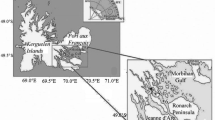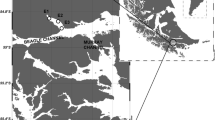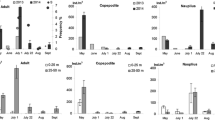Abstract
The fatty acid and alcohol composition of the pelagic amphipod, Themisto libellula, was monitored during the 5 first months of its life cycle (4–20 mm length) in an Arctic fjord, Kongsfjorden, Svalbard. Fatty acids of the three major lipid classes, polar lipids (PL), triacylglycerol (TAG), and wax esters (WE), were analyzed to highlight ontogenic changes in their diet and metabolism. The PL composition of T. libellula did not show any strong variations along their growth except during the first month where an important increase of 20:5(n-3) (EPA) and 22:6(n-3) (DHA) was observed. The TAG composition revealed a clear gradient corresponding to a diet shift from omnivorous juveniles toward carnivorous sub-adults and adults. Indeed, fatty acid trophic markers of diatoms were dominant in the juveniles, whereas 20:1(n-9) and 22:1(n-11), the Calanus sp. trophic markers, overwhelmed in the older stages. The WE composition highlighted the same general trend, however, differences were found with the TAG and are discussed as a result of differences in turnover rates and assimilation pathways between the two lipid classes.




Similar content being viewed by others
References
Ackman RG, Hooper SN, Epstein S, Kelleher M (1972) Wax esters of Barracuda lipid: a potential replacement for sperm whale oil. J Am Oil Chem Soc 49:378–382
Albers CS, Kattner G, Hagen W (1996) The composition of wax esters, triacylglycerols and phospholipids in Arctic and Antarctic copepods: evidence of energetic adaptations. Mar Chem 55:347–358
Auel H, Harjes M, da Rocha R, Stübing D, Hagen W (2002) Lipid biomarkers indicate different ecological niches and trophic relationships of the Arctic hyperiid amphipods Themisto abyssorum and T. libellula. Polar Biol 25:374–383
Benzecri JP (1973) L’analyse des données. L’analyse des correspondances, vol II. Dunod, Paris
Bligh EG, Dyer WJ (1959) A rapid method of total lipid extraction and purification. Can J Biochem Physiol 37:911–917
Bowman TE (1960) The pelagic amphipod genus Parathemisto (Hyperiidea: Hyperiidae) in the North Pacific and adjacent Arctic Ocean. Proc U S Natl Mus 112:343–392
Bühring SI, Christiansen B (2001) Lipids in selected abyssal benthopelagic animals: links to the epipelagic zone? Prog Oceanogr 50:369–382
Conover RJ, Durvasula R, Roy S, Wang R (1986) Probable loss of chlorophyll-derived pigments during passage through the gut of zooplankton and some of the consequences. Limnol Oceanogr 31:878–887
Cripps GC, Atkinson A (2000) Fatty acid composition as an indicator of carnivory in Antarctic krill, Euphausia superba. Can J Fish Aquat Sci 57:31–37
Cripps GC, Hill HJ (1998) Changes in lipid composition of copepods and Euphausia superba associated with diet and environmental conditions in the marginal ice zone, Bellingshausen Sea, Antarctica. Deep-Sea Res I 45:1357–1381
Dale K, Falk-Petersen S, Hop H, Fevolden SE (2006) Population dynamics and body composition of the Arctic hyperiid amphipod Themisto libellula in Svalbard fjords. Polar Biol 29:1063–1070
Dalpadado P (2002) Inter-specific variations in distribution, abundance and possible life-cycle patterns of Themisto spp. (Amphipoda) in the Barents Sea. Polar Biol 25:656–666
Dalpadado P, Bogstad B (2004) Diet of juvenile cod (age 0–2) in the Barents Sea in relation to food availability and cod growth. Polar Biol 27:140–154
Dalpadado P, Borkner N, Bogstad B, Mehl S (2001) Distribution of Themisto spp. (Amphipoda) in the Barents Sea and predator-prey interactions. ICES J Mar Sci 58:876–895
Dalpadado P, Yamaguchi A, Ellertsen B, Johannessen S (2008) Trophic interactions of macro-zooplankton (krill and amphipods) in the Marginal Ice Zone of the Barents Sea. Deep-Sea Res II 55:2266–2274
Dalsgaard J, St Jonh M, Kattner G, Müller-Navarra D, Hagen W (2003) Fatty acid trophic markers in the pelagic marine environment: a review. Adv Mar Biol 46:227–340
Dunbar MJ (1957) The determinants of production in the northern seas: a study of the biology of Themisto libellula (Mandt). Can J Zool 35:797–819
Dunstan GA, Volkman JK, Barrett SM, Leroi JM, Jeffrey SW (1994) Essential polyunsaturated fatty acids from 14 species of diatom (Bacillariophyceae). Phytochemistry 35(1):155–161
Falk-Petersen S, Hopkins CCE, Sargent JR (1990) Trophic relationships in the pelagic Arctic food web. In: Barnes M, Gibson RN (eds) Trophic relationships in the marine environment. Proceedings of 24th European marine biological symposium. Aberdeen University Press, Aberdeen, pp 315–333
Falk-Petersen S, Hagen W, Kattner G, Clarke A, Sargent J (2000) Lipids, trophic relationships, and biodiversity in Arctic and Antarctic krill. Can J Fish Aquat Sci 57:178–191
Falk-Petersen S, Haug T, Nilssen KT, Wold A, Dahl TM (2004) Lipids and trophic linkages in harp seal (Phoca groenlandica) from the eastern Barents Sea. Polar Res 23:43–50
Falk-Petersen S, Mayzaud P, Kattner G, Sargent JR (2009) Lipids and life strategy of Arctic Calanus, a review. Mar Biol Res 5:18–39
Graeve M, Hagen W, Kattner G (1994a) Herbivorous or omnivorous? On the significance of lipid compositions as trophic markers in Antarctic copepods. Deep-Sea Res I 41:915–924
Graeve M, Kattner G, Hagen W (1994b) Diet-induced changes in the fatty acid composition of Arctic herbivorous copepods: experimental evidence of trophic markers. J Exp Mar Biol Ecol 182:97–110
Graeve M, Kattner G, Piepenburg D (1997) Lipids in Arctic benthos: does the fatty acid and alcohol composition reflect feeding and trophic interactions? Polar Biol 18:53–61
Graeve M, Lundberg M, Böer M, Kattner G, Hop H, Falk-Petersen S (2008) The fate of dietary lipids in the Arctic ctenophore Mertensia ovum (Fabricius 1780). Mar Biol 153:643–651
Hagen W (1999) Reproductive strategies and energetic adaptations of polar zooplankton. Invertebr Reprod Dev 36:25–34
Håkanson JL (1984) The long and short term feeding condition in field-caught Calanus pacificus, as determined from the lipid content. Limnol Oceanogr 29:794–804
Haug T, Nilssen KT, Lindblom L (2004) Feeding habits of harp and hooded seals in drift ice waters along the east coast of Greenland in summer and winter. Polar Res 23:35–42
Hop H, Welch HE, Crawford RE (1997) Population structure and feeding ecology of Arctic cod (Boreogadus saida) in the Canadian High Arctic. In: Reynolds J (ed) Fish ecology in Arctic North America. American fisheries society symposium, vol 19. American Fisheries Society, Bethesda, pp 66–80
Kattner G, Hagen W (1995) Polar herbivorous copepods—different pathways in lipid biosynthesis. ICES J Mar Sci 52:329–335
Kattner G, Gercken G, Eberlein K (1983) Development of lipids during a spring plankton bloom in the northern North Sea. I. Particulate fatty acids. Mar Chem 14:149–162
Kattner G, Hagen W, Lee RF, Campbell R, Deibel D, Falk-Petersen S, Graeve M, Hansen BW, Hirche HJ, Jónasdóttir SH, Madsen ML, Mayzaud P, Müller-Navarra D, Nichols PD, Paffenhöfer G-A, Pond D, Saito H, Stübing D, Virtue P (2007) Perspectives on marine zooplankton lipids. Can J Fish Aquat Sci 64:1628–1639
Kibirige I, Perissinotto R (2003) In situ feeding rates and grazing impact of zooplankton in a South African temporarily open estuary. Mar Biol 142:357–367
Klein Breteler WCM, Schogt N, Baas M, Schouten S, Kraay GW (1999) Trophic upgrading of food quality by protozoans enhancing copepod growth: role of essential lipids. Mar Biol 135:191–198
Klein Breteler WCM, Schogt N, Rampen S (2005) Effect of diatom nutrient limitation on copepod development: role of essential lipids. Mar Ecol Prog Ser 291:125–133
Koszteyn J, Timofeev S, Weslawski JM, Malinga B (1995) Size structure of Themisto abyssorum (Boeck) and Themisto libellula (Mandt) populations in European Arctic seas. Polar Biol 15:85–92
Lee RF, Hagen W, Kattner G (2006) Lipid storage in marine zooplankton. Mar Ecol Prog Ser 307:273–306
Lischka S, Hagen W (2007) Seasonal lipid dynamics of the copepods Pseudocalanus minutus (Calanoida) and Oithona similis (Cycloploida) in the Arctic Kongsfjorden (Svalbard). Mar Biol 150:443–454
Lønne OJ, Gabrielsen GW (1992) Summer diet of seabirds feeding in sea-ice-covered waters near Svalbard. Polar Biol 12:685–692
Lorenzen CJ (1966) A method for the continuous measurement of in vivo chlorophyll concentration. Deep-Sea Res 13:223–227
Mackas D, Bohrer R (1976) Fluorescence analysis of zooplankton gut contents and an investigation of diel feeding patterns. J Exp Mar Biol Ecol 25:77–85
Mansour MP, Volkman JK, Jackson AE, Blackburn SI (1999) The fatty acid and sterol composition of five marine dinoflagellates. J Phycol 35:710–720
Marion A, Harvey M, Chabot D, Brêthes J-C (2008) Feeding ecology and predation impact of the recently established amphipod, Themisto libellula, in the St. Lawrence marine system, Canada. Mar Ecol Prog Ser 373:53–70
Mayzaud P, Albessard E, Virtue P, Boutoute M (2000) Environmental constraints on the lipid composition and metabolism of euphausiids: the case of Euphausia superba and Meganyctiphanes norvegica. Can J Fish Aquat Sci 57:91–103
Mayzaud P, Boutoute M, Alonzo F (2003) Lipid composition of the euphausiids Euphausia vallentini and Thysanoessa macrura during summer in the Southern Indian Ocean. Antarct Sci 15:463–475
Morrison WR, Smith LM (1964) Preparation of fatty acid methyl esters and dimethylacetals from lipids with borom fluoride-methanol. J Lipid Res 5:600–608
Müller-Navarra DC, Brett MT, Liston AM, Goldman CR (2000) A highly unsaturated fatty acid predicts carbon transfer between primary producers and consumers. Nature 403:74–77
Nelson MM, Mooney BD, Nichols PD, Phleger CF (2001) Lipids of Antarctic Ocean amphipods: food chain interactions and the occurrence of novel biomarkers. Mar Chem 73:53–64
Nilssen KT, Haug T, Potelov V, Timoshenko YK (1995) Feeding habits of harp seals (Phoca groenlandica) during early summer and autumn in the northern Barents Sea. Polar Biol 15:485–493
Noyon M, Gasparini S, Mayzaud P (2009) Feeding of Themisto libellula (Amphipoda Crustacea) on natural copepods assemblages in an Arctic fjord (Kongsfjorden, Svalbard). Polar Biol 32:1559–1570
Noyon M, Narcy F, Gasparini S, Mayzaud P (2011) Growth and lipid class composition of the Arctic pelagic amphipod Themisto libellula. Mar Biol 158:883–892
Nyssen F, Brey T, Dauby P, Graeve M (2005) Trophic position of Antarctic amphipods—enhanced analysis by a 2-dimensional biomarker assay. Mar Ecol Prog Ser 300:135–145
Percy JA (1993) Reproduction and growth of the Arctic hyperiid amphipod Themisto libellula (Mandt). Polar Biol 13:131–139
Peters J, Renz J, Beusekom JV, Boersma M, Hagen W (2006) Trophodynamics and seasonal cycle of the copepod Pseudocalanus acuspes in the Central Baltic Sea (Bornholm Basin): evidence from lipid composition. Mar Biol 149:1417–1429
Phleger CF, Nichols PD, Virtue P (1998) Lipids and trophodynamics of Antarctic zooplankton. Comp Biochem Physiol B 120:311–323
Ravet JL, Brett MT, Müller-Navarra DC (2003) A test of the role of polyunsaturated fatty acids in phytoplankton food quality for Daphnia using liposome supplementation. Limnol Oceanogr 48:1938–1947
Sargent JR, Falk-Petersen S (1988) The lipid biochemistry of calanoid copepods. Hydrobiologia 167(168):101–114
Sargent JR, Henderson RJ (1986) Lipids. In: Corner EDS, O’Hara SCM (eds) The biological chemistry of marine copepods, vol 1. Clarendon, Oxford, pp 59–108
Sargent JR, McEvoy LA, Bell JG (1997) Requirements, presentation and sources of polyunsaturated fatty acids in marine fish larval feeds. Aquaculture 155:117–127
Scott CL, Falk-Petersen S, Sargent JR, Hop H, Lønne OJ, Poltermann M (1999) Lipids and trophic interactions of ice fauna and pelagic zooplankton in the marginal ice zone of the Barents Sea. Polar Biol 21:65–70
Scott CL, Kwasniewski S, Falk-Petersen S, Sargent JR (2002) Species differences, origins and functions of fatty alcohols and fatty acids in the wax esters and phospholipids of Calanus hyperboreus, C. glacialis and C. finmarchicus from Arctic waters. Mar Ecol Prog Ser 235:127–134
Seuthe L, Rokkan Iversen K, Narcy F (2011) Microbial processes in a high-latitude fjord (Kongsfjorden, Svalbard): II. Ciliates and dinoflagellates. Polar Biol 34:751–766
Sugisaki H, Terazaki M, Wada E, Nemoto T (1991) Feeding habits of a pelagic amphipod, Themisto japonica. Mar Biol 109:241–244
Tamelander T, Renaud PE, Hop H, Carroll ML, Ambrose WG Jr, Hobson KA (2006) Trophic relationships and pelagic-benthic coupling during summer in the Barents Sea Marginal Ice Zone, revealed by stable carbon and nitrogen isotope measurements. Mar Ecol Prog Ser 310:33–46
Tande KS, Båmstedt U (1985) Grazing rates of the copepods Calanus glacialis and C. finmarchicus in arctic waters of the Barents Sea. Mar Biol 87:251–258
Virtue P, Mayzaud P, Albessard E, Nichols P (2000) Use of fatty acids as dietary indicators in northern krill, Meganyctiphanes norvegica, from northeastern Atlantic, Kattegat, and Mediterranean waters. Can J Fish Aquat Sci 57(Suppl. 3):104–114
Viso AC, Marty JC (1993) Fatty acids from 28 marine microalgae. Phytochemistry 34(6):1521–1533
Werner I, Auel H (2005) Seasonal variability in abundance, respiration and lipid composition of Arctic under-ice amphipods. Mar Ecol Prog Ser 292:251–262
Weslawski JM, Legeżyńska J (2002) Life cycles of some Arctic amphipods. Pol Polar Res 23:253–264
Wold A, Leu E, Walkusz W, Falk-Petersen S (2007) Lipids in copepodite stages of Calanus glacialis. Polar Biol 30:655–658
Acknowledgments
We would like to thank Kings Bay for their technical support during field work and Marc Boutoute for his advices concerning lipid analyses. This work is a contribution to the Praceal project 455 funded by the French Polar Institute Paul Emile Victor (IPEV) and the MariClim project 165112/S30 funded by the Research Council of Norway.
Author information
Authors and Affiliations
Corresponding author
Additional information
Communicated by X. Irigoyen.
Rights and permissions
About this article
Cite this article
Noyon, M., Narcy, F., Gasparini, S. et al. Ontogenic variations in fatty acid and alcohol composition of the pelagic amphipod Themisto libellula in Kongsfjorden (Svalbard). Mar Biol 159, 805–816 (2012). https://doi.org/10.1007/s00227-011-1856-7
Received:
Accepted:
Published:
Issue Date:
DOI: https://doi.org/10.1007/s00227-011-1856-7




